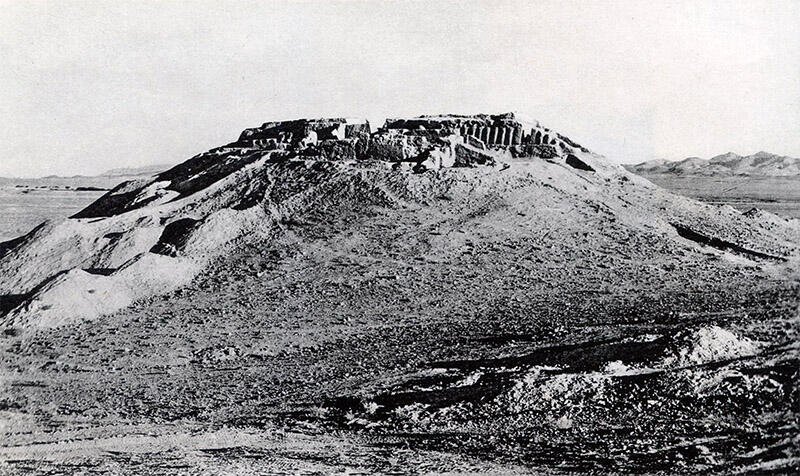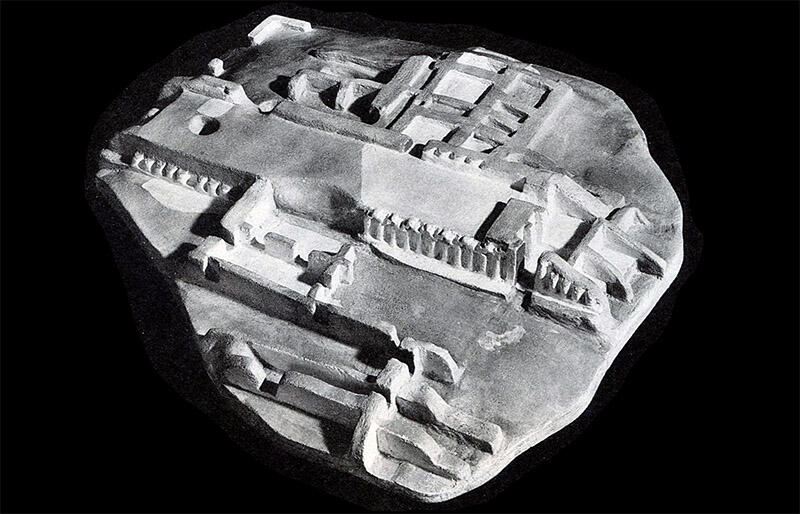It would have been an imposing site to stumble upon in 2500 BCE. It might have been even more imposing during Mundigak V [up to 1500 BCE?] when another monumental structure was built on top these colonnades, likely by a different culture or people who followed after a gap in habitation that lasted an unknown number of centuries.
"The function of this massive Period V monument is unknown," write Allchin, Ball and Hammond, "but it is reasonably certain that it was not a habitation, as it was completely devoid of the usual habitation features such as interior hearths. Furthermore, there is no indication that these rooms possessed any sort of roof structure. The only indication as to the possible purpose of this structure was the location of a ‘human sacrifice’ just outside the foundation of the surrounding terrace, where several human bones including an infant’s jaw bone were found in association with the terrace wall foundation. The human ‘sacrifice’, combined with the stepped-pyramidal shape created by the terrace walls and the massiveness of the structure itself, is certainly suggestive, as Casal noted, of the Mesopotamian ‘ziggurats’, but other monumental structures are now known elsewhere, including Nad-i Ali in Sistan and Konar Sandal in south-east Iran (discussed below). Nonetheless, the exact function of this interesting building remains to be determined." (The Archaeology of Afghanistan: From Earliest Times to the Timurid Period: New Edition, 2019 p. 188)
Sylvia Matheson writes about the end of her time with the excavation team: "That night the moon was full and yellow and shone with an in tense brilliance over the sleepy camp. Jacques and Achour took advantage of the light to go hunting for hares. The others went to bed, but I was restless. Putting on my striped quilted overcoat (for the nights were growing cold), I walked slowly up the side of Mound A to wander among the silent colonnades, the terraces, passageways, tiny rooms and spacious halls. What could this building have been? Who could have occupied it? What kind of people had they been and where had they come from? Where had they gone to, for that matter?
"I settled myself on a wall behind the columns and pictured the scene as it must have been so many thousands of years ago. Jean- Marie, like all good archaeologists, was too prudent to speak of his own theories at this stage, and unless something was found to pin- point the site, some form of datable writing for instance, it would probably be years before he could analyse all the finds, the plans, the photographs and notes, and say with any assurance who had built this great structure, what had been its purpose and who had caused its destruction. But I was no professional and nobody could stop me dreaming.
"What in fact did we actually know about Mundigak? First there had been the untouched mound as Jean-Marie had found it, rising like an upturned pudding basin some sixty feet from the soil and surrounded by its scattering of lower satellite mounds sprawling over twenty-five acres between it and the dried-up river. The river itself had probably disappeared even before the site had been abandoned three thousand years ago.
"As we could see for ourselves, the mound was on the traditional caravan route from Herat and Girishk and the still fanatical Zamindawar country to the north-west, southwards to Kandahar, Quetta and the Indus Valley, north to Ghazni and Kabul. Jean-Marie and Ginette had begun their work in 1951 by cutting a trial trench right down the side of the main mound, but with the work of the intervening years this trench had been filled until today it was only a flattened track. It had shown them that there were at least thirteen construction levels roughly ranging from the end of the fourth millennium to the beginning of the first and it was more than likely that the actual occupation of these levels would have been by more than one set of people for each building. As we had been finding, the construction levels had in fact been altered and rebuilt several times by successive occupants over a long period.
"The Casals had begun then to concentrate on the excavation of Mound A. On the top level, just below the surface, the last occupants of Mundigak had built granaries and silos of mud-pise—earth mixed with water and chopped straw. Jean-Marie had concluded that these were granaries because, though much smaller, they were very similar in design to the great granary of Harappa in the Indus Valley, consisting of parallel rows of bench-high walls for ventilation.
"Near by had been the remains of coffer-like structures that might well have been grain silos and troughs for the feeding of the animals that brought the grain for storage. Three times these granaries and dins bad been rebuilt, one on top of the other with very little iteration of design, and that pointed to a fairly long and peaceful occupation, perhaps by generations of the same peoples. In the last occupation the silos had been replaced by half-buried jars. A large pillar made of debris and covered with a plaster of pise appeared to form a centre-piece from which branched tree trunks supporting a roof. The type of structure and of pottery found here seemed to point to a fairly primitive people whose quiet life came to an abrupt end about a thousand years before the birth of Christ. That they had some inkling of impending doom was obvious from the fact that the inhabitants built a small “guard-room” complete with a sentry-walk round the inside of the walls. Remnants of fire were found in the middle of the room, a large quantity of bullets of hard clay, used for slings, and of flint arrowheads. At the same time, the number of intact bowls and jars in the room indicated that the little- defensive post had been taken without much resistance. The victors, whoever they were, did not stay, and from that day to this Mundigak had been abandoned to the wind and the sand." (Time off to Dig Archaeology and Adventure in Remote Afghanistan, London, 1961, pp. 96-98)
Images
1. Mound A, Period IV, The Palace, Final Stage.
2. Model of the Ruins (from Casal, Fouilles De Mundigak, 1961)




